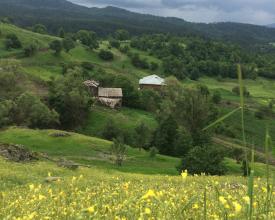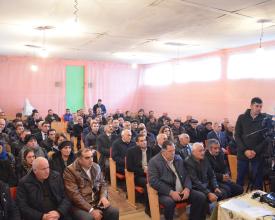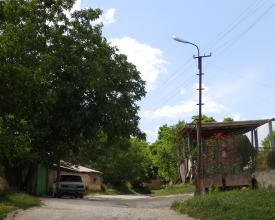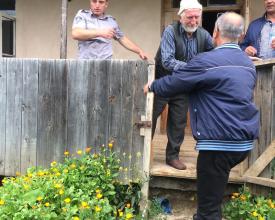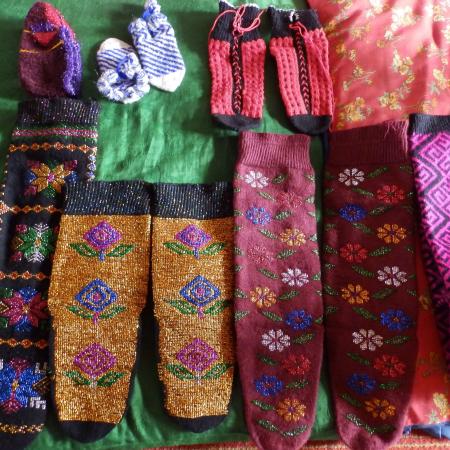
Conservation communautaire des paysages en Géorgie
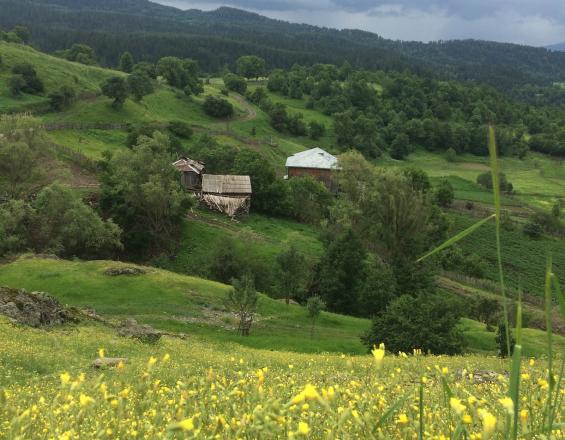
Le Fonds pour les éco-corridors du Caucase (ECF) est un instrument de financement qui soutient la conservation de la biodiversité au niveau communautaire en Géorgie, en Arménie et en Azerbaïdjan. Les éco-corridors sont créés en reliant différentes classifications de parcs et de zones protégées dans les trois pays. L'ECF utilise des accords contractuels de conservation de la nature et un ensemble clair de processus pour financer l'utilisation écologiquement durable des terres dans des régions spécifiques et des communautés sélectionnées en Géorgie. Il en résulte une mosaïque interconnectée d'habitats gérés et non gérés dans diverses catégories et classifications de terres. Ces paysages gérés par les communautés protègent, relient et soutiennent des écosystèmes indigènes sains tout en garantissant que le statut socio-économique des communautés concernées n'est pas endommagé ou diminué, mais dans de nombreux cas amélioré. ECF est une organisation de conservation pratique à but non lucratif financée par la banque de développement KfW et le WWF Allemagne.
Contexte
Défis à relever
En donnant aux populations locales la formation, l'éducation et le pouvoir de décision nécessaires pour participer à la gestion active du paysage, ECF fournit des habitats et des corridors suffisamment vastes pour maintenir des populations saines de plantes et d'animaux sans entraver l'économie locale et les modes de vie traditionnels. Le résultat est une mosaïque interconnectée d'habitats gérés et non gérés sous différentes catégories de terres et de stratégies de gestion, fournissant divers services écosystémiques ainsi qu'une solution à la fragmentation du paysage.
Grâce à la formation et à l'éducation, ECF améliore les relations et les perspectives des populations locales à l'égard de la faune et de la flore, en renforçant la sensibilisation et en encourageant le respect et la fierté à l'égard des espèces clés. Les incitations financières liées à l'"approche financière participative" contribuent à limiter les conflits entre l'homme et la faune en finançant des infrastructures de base telles que l'éclairage public et les clôtures électriques. ECF remet en question l'idée selon laquelle la conservation de la nature est synonyme de perte de valeur économique et d'activité.
Emplacement
Traiter
Résumé du processus
Chaque élément contribue à la signature d'un accord de conservation (AC) et du plan décennal de gestion de l'habitat qui l'accompagne.
- L'identification des zones de conservation prioritaires détermine les communautés qui peuvent participer à l'approche financière participative (AFP).
- L'évaluation de l'état de préparation de chaque communauté est réalisée grâce à l'approche financière participative (AFP), un outil inclusif et participatif conçu pour générer des stratégies de développement autonomes.
- La création d'organisations communautaires (OC) aide chaque communauté à établir une relation avec les ONG locales qui superviseront les aspects administratifs de l'AC.
- Lagarantie de droits d'utilisation des terres à long terme pour la communauté signifie que le programme des gardes forestiers locaux peut assurer la surveillance continue de la faune, la prévention du braconnage et la coordination de l'utilisation durable des terres sans l'obstruction des conflits d'utilisation des terres.
- Lasignature d'un accord de conservation à long terme permet d'utiliser toutes les données, les recherches et les pratiques de renforcement de la communauté issues des étapes précédentes et d'orienter la communauté vers des objectifs de conservation réalisables et efficaces.
Blocs de construction
Identifier les zones de conservation prioritaires à l'aide de modèles d'adéquation de l'habitat pour les principales espèces animales.
La sélection de 3 à 4 espèces animales indigènes qui représentent le mieux le paysage permet d'incarner les écosystèmes spécifiques qui ont besoin d'être protégés ou gérés. L'identification des espèces cibles permet à ECF de créer une approche de la conservation de la faune et de la flore faciles à comprendre pour la population locale - en liant directement une espèce charismatique aux pratiques de gestion du paysage - et de fournir à la population locale un lien tangible entre ses efforts de conservation quotidiens et l'impact à long terme sur le paysage. Par exemple, si les écosystèmes des prairies indigènes sont sains, le cerf élaphe du Caucase reviendra, même s'il avait disparu localement. La présence de ces espèces animales indigènes clés est ensuite utilisée comme indicateur de la biodiversité lors de la création d'accords de conservation.
Une étude des habitats existants et potentiels des espèces clés est réalisée à l'aide d'une combinaison de données de télédétection et de données de terrain. À l'aide du logiciel MAXENT (Maximum Entropy Modeling), des modèles d'adéquation de l'habitat sont créés pour chaque espèce clé, ce qui permet d'établir des cartes montrant l'adéquation des habitats pour les espèces clés. Cette approche permet aux autorités locales d'établir un lien clair entre les objectifs de conservation, les mesures à mettre en œuvre et les effets escomptés. Elle permet également de fixer des priorités pour les études ultérieures et de surveiller les espèces/habitats.
Facteurs favorables
1. Accès à des données de télédétection actuelles et précises sur les paysages - ESRI, USGA NOAA, etc.
2. Formation du personnel à l'utilisation des SIG et des logiciels de modélisation.
3. Combinaison de données et de connaissances locales et spécialisées sur les espèces clés
4. Accès aux données de terrain des ONG qui travaillent actuellement/précédemment dans la région.
Leçon apprise
- La modélisation de l'adéquation de l'habitat offre une méthode économique et rapide pour établir des priorités géographiques et thématiques de conservation dans un paysage complexe.
- Même avec une disponibilité limitée de données d'observation sur le terrain, les résultats sont utiles dans les premières étapes de la planification, bien qu'il faille garder à l'esprit les limites de la qualité des données d'entrée.
- Les cartes d'adéquation de l'habitat représentent une bonne base de discussion sur les objectifs, les priorités et les mesures de conservation avec les différentes parties prenantes, y compris la population locale.
L'outil de l'approche financière participative (AFP)
L'approche financière participative (AFP) d'ECF est une méthodologie qui utilise des subventions financières directes pour mobiliser les populations locales afin qu'elles prennent en charge leur propre développement. Elle est conçue pour générer des stratégies de développement autonomes qui sont constructives, inclusives et très participatives au niveau de la famille, de la communauté et de la région.
Animés par des ONG locales dans l'ensemble du corridor occidental du Petit Caucase, des concours de narration permettent de décrire la relation entre les habitants et les principales espèces animales sauvages sélectionnées pour représenter au mieux les paysages et incarner les écosystèmes ayant besoin d'être protégés/gérés. Ces concours sont suivis d'activités visant à améliorer simultanément les habitats des animaux et les moyens de subsistance de l'homme, parallèlement aux modèles d'adéquation de l'habitat. Le processus d'APF permet de développer une relation positive et basée sur la confiance entre ECF et les habitants.
La participation à un APP conduit à l'élaboration du contrat de conservation à long terme d'ECF (accord de conservation) et encourage les habitants à devenir des décideurs et des gardiens des ressources naturelles, tout en favorisant un sentiment de fierté et de protection pour les principales espèces sauvages. Les APP abordent également les questions sous-jacentes liées au régime foncier et à l'utilisation des terres qui sont à l'origine des problèmes de conservation (braconnage, utilisation non durable et illégale des ressources).
Facteurs favorables
- Disponibilité d'ONG locales ayant l'expérience et la capacité de faciliter les processus communautaires
- Soutien des autorités locales et d'autres institutions par le biais de groupes de travail régionaux
- Établissement d'un lien entre les coutumes traditionnelles, les modes de communication, la prise de décision et les méthodes modernes, tout en préservant les valeurs culturelles et traditionnelles existantes.
- Mise en œuvre d'incitations financières sans conditions
- Renforcement des capacités et formations à la demande pour répondre aux besoins émergents des communautés locales.
Leçon apprise
- Les incitations financières inconditionnelles suscitent un intérêt initial pour le projet et génèrent ensuite la fierté, la satisfaction et la motivation de la communauté une fois que les incitations sont utilisées pour améliorer la situation de la communauté.
- La méthodologie des APP doit être adaptée à la finalité et aux objectifs de chaque projet.
- La mise en œuvre de petits projets gérés par les communautés est essentielle pour déterminer quelles communautés sont engagées et compétentes pour s'engager dans une coopération à plus long terme.
- L'intégration des connaissances traditionnelles aux modèles et stratégies modernes crée une fusion des contributions scientifiques et communautaires.
- Les questions foncières sont identifiées très tôt et permettent à ECF d'évaluer la viabilité des projets.
- L'introduction de structures de base de la société civile par la création de comités villageois, de groupes de travail régionaux auto-coordonnés, d'un suivi régulier des projets et de réunions annuelles.
Création d'organisations communautaires (OC)
La création d'une OCB est l'étape qui sépare le processus d'APF de la signature d'un accord de conservation. Les organisations communautaires sont créées avec l'aide d'ECF et sont responsables de ce qui suit
i) de garantir et de mettre en œuvre un accord de conservation
ii) de la distribution juste et équitable des bénéfices au sein de la communauté
iii) agir en tant qu'entité légale représentant la communauté dans un accord de conservation.
Les organisations communautaires sont constituées en vertu de la législation nationale appropriée à leur objectif, au pays et à la région. Si la création d'une OCB n'est pas possible, une ONG peut agir en tant qu'OCB dans l'accord de conservation.
La création d'une OCB exige de la communauté locale qu'elle s'engage à long terme à coopérer et à assumer la responsabilité des actions de conservation. De cette manière, l'OCB contribue à renforcer le capital social et à accroître les pratiques d'utilisation durable des terres. Les organisations communautaires aident à renforcer les liens entre les communautés, la communication et la résilience en ce qui concerne les efforts de conservation de la nature. Les organisations communautaires sont encouragées à considérer la biodiversité comme faisant partie de l'économie locale et à travailler en étroite collaboration avec ECF pour convenir d'une utilisation durable des terres. Les organisations communautaires sont encouragées à rechercher d'autres sources de financement pour les projets communautaires et à développer leurs activités en tant qu'entreprise durable au cours de la période de mise en œuvre de l'accord de conservation.
Facteurs favorables
- L'auto-organisation des communautés est initiée ou renforcée par l'intermédiaire de l'APF.
- Négociation des conditions avec les représentants de la communauté afin d'obtenir un accord de conservation clair et à long terme.
- Dialogue, négociation et implication de tous les segments de la communauté : anciens, décideurs, membres influents de la communauté, femmes et jeunes.
- Identifier et inclure tous les groupes d'utilisateurs au sein d'une communauté : éleveurs, agriculteurs, chasseurs, guérisseurs.
- Implication des autorités locales (par exemple, le département des forêts)
- Engagement stratégique avec les institutions aux niveaux régional et national
Leçon apprise
- L'absence de gouvernance au niveau communautaire, le manque de sensibilisation à l'environnement et les interactions négatives avec la faune ont nécessité des campagnes d'éducation et de sensibilisation de la communauté.
- De petits projets menés localement encouragent le renforcement des capacités communautaires, la communication et la mise en œuvre de stratégies de conservation.
- La création d'organisations communautaires représente un progrès de l'APF et une amélioration qualitative en termes d'auto-organisation locale.
- N'imposez pas un modèle d'organisation à la communauté locale ; décidez ensemble d'un modèle.
- Le renforcement des capacités en matière de gestion et de gouvernance des organisations communautaires est essentiel pour garantir le succès initial et réduire la dépendance à l'égard de l'aide extérieure.
- L'implication de l'OCB dans l'acquisition et l'organisation d'informations de base sur les questions liées aux moyens de subsistance, aux ressources naturelles et à l'utilisation des terres permet d'obtenir des informations pertinentes et contribue au renforcement des capacités de l'OCB.
- L'acceptation des points de vue des membres de la communauté lors de la définition des objectifs du projet permet de s'assurer que le projet sert l'ensemble de la communauté.
- L'implication des autorités locales permet de relier les applications de la gestion basée sur les écosystèmes à des thèmes plus vastes tels que le changement climatique et la réduction des risques de catastrophe.
Garantir les droits d'utilisation des terres à long terme pour la communauté et les objectifs de conservation
Une propriété foncière claire et un régime foncier (le droit d'utiliser la terre) sont les conditions préalables de base pour la mise en œuvre de toute mesure de gestion de l'habitat. Les droits d'utilisation des terres de tous les bénéficiaires doivent être clairs et garantis avant le début des initiatives du projet afin d'éviter le risque de dimensions non documentées dans la planification et la mise en œuvre des mesures de conservation. Cela permet également de garantir l'intérêt à long terme de l'utilisateur des terres pour une gestion durable de celles-ci. L'objectif de cette mesure est de clarifier, de réglementer légalement, d'obtenir et de détenir les droits fonciers nécessaires aux actions de conservation et aux moyens de subsistance durables. Les droits fonciers englobent la propriété foncière, la location de terres et/ou d'autres droits liés à l'utilisation des terres.
En Géorgie, la plupart des terres appartiennent à l'État. Mais après l'effondrement de l'Union soviétique, les droits fonciers n'ont pas été correctement documentés ou enregistrés. Aujourd'hui, les droits traditionnels d'utilisation des terres basés sur des accords verbaux et des traditions sont traduits en baux légalement documentés/enregistrés par les organisations communautaires représentant leurs villages respectifs. La résolution de l'incertitude foncière est l'un des principaux avantages que l'ECF apporte aux communautés partenaires, en leur offrant une perspective économique claire pour l'avenir tout en préservant la gestion communautaire existante des pâturages et des prairies partagés.
Facteurs favorables
- Préparation des autorités foncières de l'État à la documentation et à l'enregistrement des droits d'utilisation des terres communautaires existants
- Réalisation d'une étude foncière pour comprendre les incertitudes foncières et les droits existants
- Cartographie précise de l'ensemble de la zone de conservation et communication de ces résultats (cartes, chiffres, rapports) accessibles à la communauté et aux autorités.
- Participation active des autorités locales (au niveau de la municipalité et du département)
- Implication volontaire des autorités locales, des départements et de l'administration
- Compensation adéquate pour l'utilisation des terres
Leçon apprise
- Identifier correctement les droits d'utilisation des terres et les questions en suspens, y compris la recherche, la collecte de données et l'analyse SIG effectuées i) de manière formelle (collecte de données municipales et régionales), et ii) de manière informelle (discussions avec les habitants).
- Prise en compte de la documentation des informations et de l'absence de documentation. Les habitants peuvent utiliser les pâturages/prés de manière traditionnelle, avec peu ou pas de documentation sur leurs droits d'utilisation. Dans le cadre du projet, l'utilisation des terres doit être considérée à la fois dans les contextes formels/politiques et dans les contextes informels/traditionnels.
- Communication entre les multiples organismes de gestion des terres en Géorgie (État, municipalité, communauté, privé) et les désignations d'utilisation des terres (forêts, agriculture, zones protégées, terres privées). Des relations positives et une communication active avec toutes les parties prenantes conduisent à des relations de travail saines.
- La prise en compte des politiques nationales et régionales fait partie intégrante de la garantie des droits d'utilisation des terres.
- Budgétisation suffisante des coûts nécessaires à l'obtention des droits d'utilisation des terres.
Création d'un programme de gardes forestiers locaux
Pour mettre en œuvre efficacement les mesures de conservation, les projets ont besoin de personnes dévouées, qualifiées et formées sur le terrain et au sein de la communauté. La mise en place d'un programme de gardes forestiers locaux appelé "Caretakers" a été identifiée par ECF comme une étape importante pour s'assurer que les objectifs de conservation sont appliqués sur le terrain et compris dans le village. Les gardiens sont des personnes locales qui connaissent et comprennent leur environnement local, qui sont capables de communiquer avec les habitants et les visiteurs et qui sont motivées pour protéger la nature. Ils sont identifiés dans le cadre du processus d'APF et sont ensuite employés par les organisations communautaires. Ils sont formés aux méthodes de conservation, équipés de matériel de communication, d'uniformes et parfois de moyens de transport, mais n'ont pas les droits légaux du personnel (gouvernemental) des zones protégées ou des gardes forestiers. Ils peuvent informer et éduquer les gens et signaler les infractions aux autorités compétentes. Les gardiens participent à la surveillance de la biodiversité, à l'éducation et à la sensibilisation et effectuent des tâches de gestion de l'AC. Ils sont responsables de la collecte des données, de la surveillance continue de la faune et de la flore et de la soumission de rapports d'avancement à l'ECF. Les gardiens constituent un point de contact clé (fiable et respecté) au sein de la communauté et illustrent les avantages socio-économiques de la conservation de la nature.
Facteurs favorables
- Une sélection prudente signifie que les personnes choisies sont dignes de confiance, qu'elles ont la capacité d'acquérir de nouvelles compétences, qu'elles sont ouvertes à l'acceptation de nouvelles idées et qu'elles ont la responsabilité de rendre compte et de réaliser les objectifs.
- Implication des gardiens dans tous les aspects du renforcement des capacités des institutions et autorités locales impliquées dans la gestion des terres et la conservation de la nature, y compris les agences forestières, les municipalités, etc.
- Participation à des sessions de formation utilisant les outils/compétences requis pour le poste et encourageant une éthique forte, l'honnêteté et l'engagement envers les objectifs de conservation de la nature.
Leçon apprise
- L'émigration des jeunes est un obstacle à la recherche d'un gardien approprié pour les objectifs et l'application du projet à long terme.
- L'éducation des communautés aux pratiques et aux applications de la gestion écosystémique remettra en question les perspectives antérieures sur la faune et la flore tout en démontrant comment la conservation peut bénéficier à la communauté et développer le respect pour le poste de gardien.
- Les autorités locales et les organisations communautaires sont institutionnellement faibles, c'est pourquoi un renforcement général des institutions et des capacités est encouragé.
- Le rôle des gardiens est initialement mal compris par les autorités locales. Des efforts et un accompagnement sont nécessaires pour faire comprendre que le maintien de l'ordre et l'application des lois ne représentent qu'une partie mineure du travail des parties prenantes et que l'accent doit être mis sur la sensibilisation, la fourniture d'informations et de conseils, ainsi que sur le leadership au sein de la communauté locale.
- En veillant à ce que les personnes qui s'occupent des enfants reçoivent une éducation et une formation, il est possible d'accéder aux outils et aux ressources employés et de les utiliser.
Engagement à atteindre des objectifs de conservation explicites et réalisables par le biais d'accords de conservation à long terme
Lesaccords de conservation (AC) sont des contrats de subvention contraignants créés et approuvés par des communautés spécifiques et l'ECF. Les accords de conservation définissent des objectifs de conservation clairs, réalisables et réalistes et déterminent la portée des mesures de conservation à mettre en œuvre au sein des communautés qui démontrent qu'elles ont l'organisation, la motivation et l'engagement nécessaires pour suivre des plans de gestion de l'habitat sur dix ans. Les objectifs de conservation sont déterminés par l'ECF et la communauté locale à l'aide de connaissances spécialisées et locales. Chaque accord est adapté aux besoins identifiés dans la communauté cible et au paysage local. Ces contrats engagent les communautés à protéger les écosystèmes, mais aident également les utilisateurs traditionnels des terres à les exploiter de manière durable.
Les communautés qui signent les accords de conservation ont été sélectionnées parce qu'elles ont fait preuve d'initiative, d'implication communautaire et de potentiel grâce au processus d'APP et à la création d'une organisation communautaire. Afin de garantir la durabilité des projets, le respect des accords de conservation est contrôlé. Chaque communauté doit soumettre des rapports techniques annuels. Si elles ne réalisent pas les activités prévues, les paiements au titre de l'accord peuvent être suspendus jusqu'à ce qu'elles remplissent les conditions requises, ou résiliés si elles ne respectent pas les conditions pendant plus d'un an.
Facteurs favorables
- Application réussie de l'APF ; pratique des communautés à l'aide d'outils, de modèles et de financements
- Développement d'une philosophie de soutien et d'éducation, et non de maintien de l'ordre.
- Sélection minutieuse des communautés qui démontrent les compétences, l'organisation et l'implication nécessaires pour mettre en place des mesures de conservation
- Formation et éducation pour prendre des décisions et gérer les paysages en coopération avec les idéaux de conservation de la nature.
- La définition claire des activités financées donne un sens à l'action des organisations communautaires.
- Aider les communautés à obtenir des fonds supplémentaires
Leçon apprise
- Une expertise technique n'est nécessaire que dans de très rares cas pour des questions spécifiques liées à l'accord sur les plans de gestion de l'habitat.
- Les estimations de coûts ont été élaborées en coopération avec les représentants des communautés locales, sur la base de leur connaissance des marchés locaux. Le résultat final est qu'un remboursement équitable de l'intégralité des coûts est fixé par les accords de conservation, ce qui permet aux organisations communautaires de mettre en œuvre les accords de conservation et d'assurer leur viabilité économique au cours de la période contractuelle.
- Les rapports communautaires annuels comprennent : une comparaison des valeurs ciblées et réelles pour les mesures planifiées ; les développements dans les délais du projet ; un rapport financier général ; des informations sur les problèmes et l'identification des solutions possibles.
- Chaque année, un échantillon d'accords de conservation est sélectionné pour faire l'objet d'un audit indépendant par ECF ou une tierce partie. C'est l'occasion d'examiner le suivi et les rapports en tant que méthode pour tester la performance du processus d'accord de conservation.
- L'examen des liens entre l'objectif de conservation et la résilience/les moyens de subsistance des populations locales permet d'orienter les projets futurs.
Impacts
ECF améliore la connectivité des habitats dans le Caucase en combinant les connaissances locales et l'action communautaire avec des données scientifiques et des pratiques modernes de gestion de l'utilisation des terres. La création d'éco-corridors relie les parcs et les zones protégées, contribuant ainsi à la préservation de la biodiversité à l'intérieur et à l'extérieur des zones protégées et au-delà des frontières nationales. L '"approche financière participative" est une approche communautaire qui fonctionne parallèlement aux modèles de paysage. Ce processus permet à ECF d'identifier les communautés qui sont prêtes à s'engager dans des objectifs de conservation tout en développant une relation de confiance. Il s'agit de la première étape vers un "accord de conservation" et elle a des effets positifs qui permettent aux habitants de devenir des décideurs et des gardiens des ressources naturelles tout en développant la fierté et la protection des espèces clés. L'amélioration de la productivité pastorale et agricole et les incitations financières encouragent le mariage de la conservation et du bien-être de la communauté. Les accords de conservation récompensent les habitants et leur donnent les moyens de préserver la nature et la culture locale, ce qui conduit à la création d'organisations communautaires de conservation et de plans d'utilisation durable des terres qui prennent en compte la biodiversité et l'économie locale. Des processus de surveillance spécifiques sont mis en œuvre, notamment la désignation de "gardiens" qui surveillent et suivent les mouvements de la faune et font respecter les lois anti-braconnage.
Bénéficiaires
Villages bénéficiaires : Dertseli, Mokhe, Naminauri, Tsikhisubani
Villages prioritaires de Furture : Didi Zanavi, Patara Zanavi, Gomaro, Nakurdevi, Khevasheni, Bolajuri, Kvemo Enteli, Chorchani, Didi Smada, Patara Smada, Tsre, Pkhero, Shoka, Zemo Enteli, Kikibo.
Objectifs de développement durable
Histoire

La région d'Adigeni en Géorgie et l'écorégion du Petit Caucase occidental d'ECF sont connues pour leurs monastères historiques et leur ancienne métallurgie. Dehrseli est une petite communauté de la région qui a été identifiée comme candidate au programme ECF. Il y a plus d'un an, la communauté a pris part à l'approche financière participative d'ECF, un processus qui aide l'administration d'ECF à évaluer si une communauté est ouverte et capable de s'engager dans un accord de conservation. Zaza Shavadze est un leader respecté de la communauté de Dertseli et un membre du conseil d'administration de l'Union communautaire de Dertseli. Sa famille et sa communauté sont un exemple des effets positifs du programme ECF.
Le FPA offre une incitation financière à une communauté pour la récompenser d'avoir pris des mesures spécifiques la préparant à conclure un accord de conservation à l'avenir. Certaines de ces mesures comprennent la création d'une collaboration avec une ONG ou une institution partenaire pour superviser les progrès, le développement d'une capacité de leadership communautaire et la garantie d'une participation de la communauté à de multiples niveaux - des écoliers aux décideurs de la communauté. L'aide financière n'est assortie d'aucun paramètre et la communauté peut utiliser l'argent à sa guise, qu'il s'agisse d'installer l'éclairage public ou d'améliorer l'état des routes. Certaines communautés, comme Dehrseli, ont été encouragées par l'augmentation du tourisme dans la région et s'efforcent de créer de nouvelles opportunités économiques liées au tourisme. Un groupe de femmes de la communauté de Dehrseli a commencé à fabriquer des chaussettes qu'elles vendent aux touristes et sur les marchés locaux.
L'outil FPA aide à développer un niveau de confiance entre la communauté et ECF, démontrant qu'ECF ne cherche pas à faire la police ou à réduire les activités économiques liées à l'utilisation des terres, mais à favoriser un partenariat basé sur l'amitié et la confiance où le bien de la communauté est intégré dans les objectifs de conservation de la faune et de la flore. L'objectif de l'ECF dans son ensemble est de contribuer à la conservation écologique dans le Caucase sans réduire les revenus des populations rurales et le FPA s'est avéré être un tremplin essentiel pour atteindre cet objectif.

